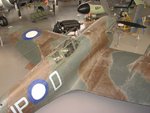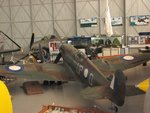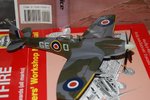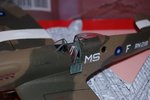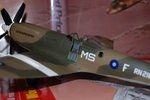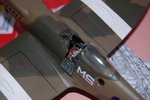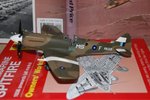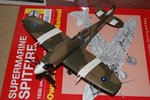Airframes
Benevolens Magister
Here you go Steve, the classic Charles Brown photo of BL479, of 316 (Polish) Sqn., R.A.F. Some captions put the pic as late 1943 or early 1944, although I do remember seeing a note in a book on Charles Brown's work, where the date was given as February 1944.
I'm afraid I haven't found the other shots yet, apart from a B&W version of the same pic, but to be honest, there's not a lot to show - the aircraft appears to be pristine, almost factory fresh, all over!
Two things to note; the doped patch on the rear fuselage, and the sliding canopy frame. Although it's possible that the patch is a gas detector panel, I don't think it is. It looks more like a repair patch or similar, possibly fabric, doped-on as a temporary measure?
The frame of the sliding canopy appears to be a much lighter colour, possibly grey primer, and I think this might be a replacement canopy, with the later, bulged hood. Until I find the other pics, of the port side, I'm unable to confirm whether the Polish red white emblem was carried on the nose cowling panel, but I'm fairly sure it was.
It's always interested me that this kite has the later prop and 'pointed' spinner, but the early, externally armoured windscreen, and the smaller than 'regulation' code letters. When I eventually get around to building a Hasegawa 1/32nd scale Spit straight from the box, instead of converting to Mk1, MkIX and MkXIV, this is the one I'll be doing!
I'm afraid I haven't found the other shots yet, apart from a B&W version of the same pic, but to be honest, there's not a lot to show - the aircraft appears to be pristine, almost factory fresh, all over!
Two things to note; the doped patch on the rear fuselage, and the sliding canopy frame. Although it's possible that the patch is a gas detector panel, I don't think it is. It looks more like a repair patch or similar, possibly fabric, doped-on as a temporary measure?
The frame of the sliding canopy appears to be a much lighter colour, possibly grey primer, and I think this might be a replacement canopy, with the later, bulged hood. Until I find the other pics, of the port side, I'm unable to confirm whether the Polish red white emblem was carried on the nose cowling panel, but I'm fairly sure it was.
It's always interested me that this kite has the later prop and 'pointed' spinner, but the early, externally armoured windscreen, and the smaller than 'regulation' code letters. When I eventually get around to building a Hasegawa 1/32nd scale Spit straight from the box, instead of converting to Mk1, MkIX and MkXIV, this is the one I'll be doing!
Attachments
Last edited:


